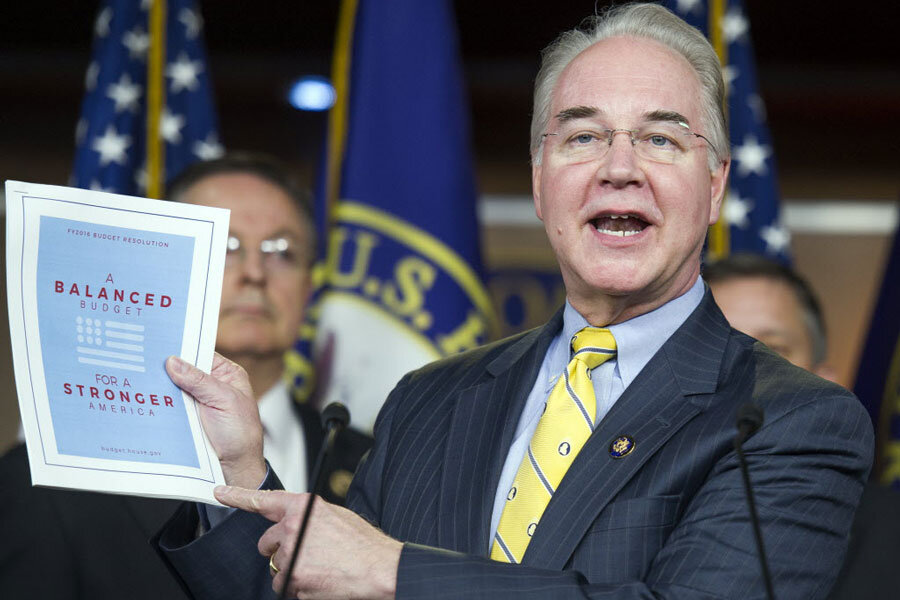Hawk v. hawk: Can GOP balance fiscal goals with higher military spending?
Loading...
| Washington
Republican lawmakers are pushing to pass budget plans this week that aim to constrain the size of government while also freeing defense spending from arbitrary caps.
It’s a thorny political challenge, since in both the House and the Senate some conservatives call for a tighter focus on fiscal discipline, while others say that effort shouldn’t get in the way of maintaining a strong US military.
Even if Republican majorities in the two chambers do rally around budget plans in votes this week, things could get more complicated from there on the road toward the new fiscal year, which starts Oct. 1.
Here’s a briefing on the issues in play:
1. Republicans who control Congress have recently released budget plans. What are their key goals?
The House and Senate plans differ in details but share an overarching theme. They’d put a sharp squeeze on the growth of government spending, compared with status quo projections for the next decade. In their vision, federal deficits would eventually come down to zero by 2025, without raising new tax revenue.
Spending cuts would hit food stamps, welfare, and the size of Pell Grants for college. Medicare would also face cuts, with the Senate leaving the details to be determined later and the House budget outlining changes that critics deride as using vouchers to “end Medicare as we know it.”
Behind all this is the idea that leaner government, low taxes, and a shrinking debt burden will help Americans have a stronger economy – with more money to invest in the kind of private sector activity that raises productivity and incomes.
Outside policy analysts say the Republicans use accounting tricks to claim that balanced budgets can arrive without new taxes.
2. How does this differ from President Obama’s budget proposal?
The Obama plan calls for about $50.3 trillion in federal spending over the next 10 years, while Republicans outlines come in more than $7 trillion below that mark. The White House sees its plan racking up an estimated $5.7 trillion in deficits, while the Republican deficits would total about one-fourth of that figure for the decade.
The big theme of the Obama budget proposal is “middle class economics.” The Republican agenda would undercut the investments in education, infrastructure, and job training that are needed for average workers to prosper, he argues.
Both sides say they’re keeping an eye on the need for fiscal discipline.
The House Republican budget sees national debt falling by 2025 to 55 percent of one year’s gross domestic product. The progress would come by having debt grow slower than the GDP.
Obama touts the goal of stabilizing the national debt at about 73 percent of GDP – with the prospect of reducing it from there if the two sides can agree on reforming entitlement programs.
For reference, public debt stayed below 40 percent of GDP for most of the period between 1960 and 2008.
3. Both sides say they want to end the spending caps called sequestration, partly to allow higher defense spending. Could a shutdown happen if they can’t agree on that?
In the 2011 Budget Control Act, both parties agreed on arbitrary spending limits to put some brakes on future deficits, even if Congress couldn’t agree on a formal budget plan. This sequestration system is disliked by both parties. But where many Republicans worry especially about the impact on defense spending, Democrats also lament the squeeze on domestic spending.
Even if Republicans agree on a budget blueprint, that will need to be followed up with appropriations bills. Obama may veto bills that don’t end the arbitrary caps.
And among themselves, Republicans are having to bridge a divide between fiscal hawks, whose priority is spending cuts, and defense hawks who say national security will suffer if the caps for military spending aren’t lifted.
If all these differences don’t get worked out, it’s possible the nation could enter the new fiscal year in October without legislation to fund the government. A partial government shutdown (involving activities deemed nonessential) would follow until a plan emerges.
4. Is it true that Obamacare could also be affected by the budget?
Yes and no. Republicans would love to pass a measure to repeal the Affordable Care Act, and the budget offers a way around the threat of a filibuster by Democrats in the Senate. But Obama would surely veto the ACA repeal. Still, Republicans see all this as a way to keep their “repeal and replace” idea alive heading into the 2016 presidential election.
Here’s why the budget opens the door to a repeal bill. Passing a budget can be done with a simple majority vote (no need for 60 senators on board to override a filibuster threat), and it doesn’t require a presidential signature. In turn, the budget resolution can include language that paves the way for something called “reconciliation” – a vehicle for passing certain additional budget-related bills by majority vote.
5. What's the strategy now for both sides?
For Republicans, even agreeing among themselves won’t be easy. After separate passage in House and Senate, the two budget plans would need to be merged in a joint conference committee, in a way that retains majority support.
If that effort is successful, it would set the stage for an Obamacare repeal measure. But agreeing on a budget wouldn’t settle the question of what can actually be spent for defense and non-defense programs in 2016. That’s because the follow-on spending bills require a presidential signature.
Obama will use his platform as president to push for plans closer to his own budget vision. And, to avoid a shutdown, the two sides will need to find a path forward that’s palatable enough by the time the new fiscal year starts on Oct. 1.








